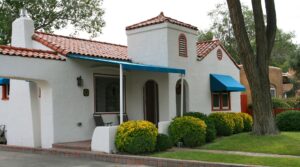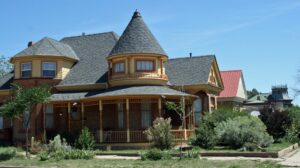After the National Historic Preservation Act of 1966 was adopted, New Mexico established historic districts in Spanish colonial neighborhoods, territorial boomtowns, American downtowns, eastern plains and oil patch towns. These districts preserve the best of New Mexico’s architectural landmarks.
- Posts: 34 -
Mesquite Historic District

Constructed 1849. The Mesquite District is recognized as part of the Camino Real de Tierra Adentro, the historic Spanish Intercontinental Royal Route from Mexico City to Santa Fe. The original town site is rich in history and culture, with 22 of the original blocks still in existence and more than Read more…
Monte Vista and College View Historic District

Constructed 1930. On the north side of Central, the Monte Vista Addition was platted in 1926 by William Leverett. Due to topography and drainage concerns, the streets were laid out in an irregular pattern around two intersecting diagonal boulevards, Campus and Monte Vista. Leverett also set aside a large plot Read more…
Mora Historic District

Constructed 1900 Mora was founded in 1835 after a land grant was awarded to settlers by the Mexican government. The land grant was called “Santa Gertrudis de Mora†thereby establishing St. Gertrude as the patron saint of the fledgling village. Mora residents rebelled against the new American regime in 1847 Read more…
NMMI Historic District
Constructed 1920. New Mexico Military Institute was founded by Colonel Robert S. Goss and Captain Joseph C. Lea in 1891, originally as the Goss Military Academy, with an initial enrollment of 28 students. In 1895 it acquired the land at its current location, and in 1910 it received land-grant status Read more…
North New Town Residential Historic District

Constructed 1900 The large residential neighborhood north of Carnegie Park and east of the campus of New Mexico Highlands University contains a dazzling variety of historic residences reflecting nearly every popular historic architectural style during the gilded age of Las Vegas, 1890-1920. Many of the city’s leading citizens built homes Read more…
Old Town Residential Historic District

Constructed 1880 After the Civil War, the prosperity of the Santa Fe Trail enabled the village of Las Vegas to expand out of the plaza vicinity. New adobe homes were built along the hillside near Our Lady of Sorrows Church and the Presbyterian mission church to the south. Some prosperous Read more…
Original Townsite Historic District

Constructed 1880. The original 320 acres for the Raton townsite were purchased from the Maxwell Land Grant in 1880. In 1879, the Atchison, Topeka and Santa Fe Railroad bought a local toll road from famed frontier entrepreneur “Uncle Dick” Wooton and established a busy rail line. Raton quickly developed as Read more…
Plaza Historic District

Constructed 1835 After the Las Vegas plaza was founded near the Gallinas River in 1835, settlers quickly took advantage of the growing commerce on the Santa Fe Trail. The plaza of Las Vegas was the first settlement weary caravans encountered after nearly 800 miles on the buffalo plains, and villagers Read more…
Railroad Avenue Historic District

Constructed 1890 On July 4, 1879 a rowdy crowd greeted the first Iron Horse locomotive in the New Mexico Territory at the Las Vegas railyard. Within days and weeks, a ramshackle collection of tents and wooden makeshift businesses appeared, attracting fortune seekers from hundreds of miles away. Great mercantile companies Read more…
Raton Downtown Historic District

Constructed 1930. Developed in the late nineteenth and early twentieth centuries, the Raton Downtown Historic District contains fine examples of the Romanesque Revival, Italianate, and Queen Anne styles, as well as the later Decorative Brick Commercial and Mission and Spanish Colonial Revival styles of the 1920s, 30s, and 40s. The Read more…